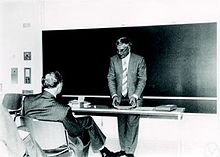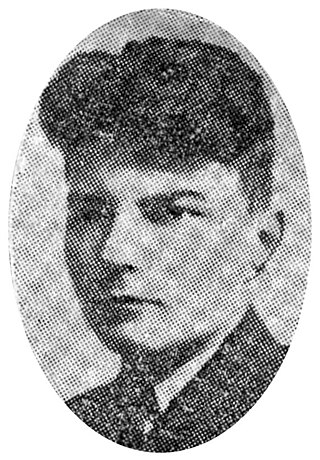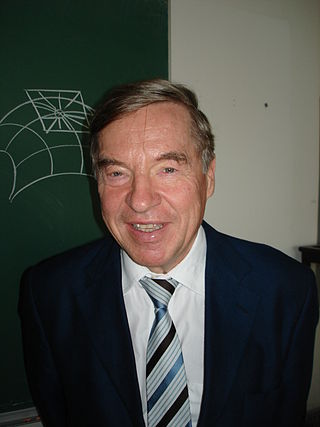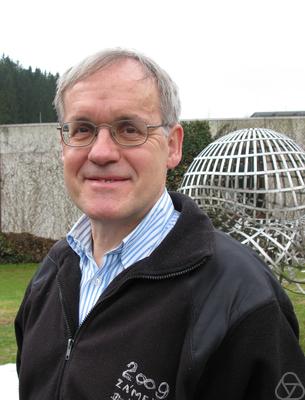
Cornelis Gerrit Lekkerkerker (Harmelen, 7 February 1922 – 24 July 1999) was a Dutch mathematician.

Cornelis Gerrit Lekkerkerker (Harmelen, 7 February 1922 – 24 July 1999) was a Dutch mathematician.
Lekkerkerker studied mathematics at Utrecht University during the periods 1940-1943 and 1945-1949 under Jurjen Koksma and Jan Popken. After completing his studies in 1949, he started work at the Amsterdam Centrum Wiskunde & Informatica (National Research Institute for Mathematics and Computer Science), where he worked under Koksma in the pure mathematics division. In the academic year 1953-1954, he studied in Rome. [1] In 1955 he received his doctorate under the guidance of Popken with the thesis On the Zeros of a Class of Dirichlet-Series ; in Dutch: Over de nulpunten in een klasse van Dirichletreeksen. [2]
Beginning in 1961, he was a professor at the University of Amsterdam, succeeding Nicolaas Govert de Bruijn. He was the director of the Mathematical Institute during the student protests of 1969-1973. In 1984, although he had not yet reached retirement age, he resigned his professorship over differences in the teaching of mathematical analysis, feeling that his academic freedom was under threat. [1]
He was a co-editor of Mededelingen van het Wiskundig Genootschap (correspondence of the Mathematical Society). [1]
Lekkerkerker worked on analytic and geometric number theory. He wrote the standard work Geometry of Numbers, first published in 1969. Later he worked on topics in functional analysis. In the 1970s, he turned his attention towards the mathematical treatment of topics in nuclear physics (e.g. neutron transport) and astrophysics (e.g. radiation transport within stars). Afterwards he worked with Rutger Hangelbroek, who did his doctorate under Lekkerkerker in 1973 at the University of Groningen, and Hans Kaper of the Argonne National Laboratory. He also contributed to topics in graph theory and topology. [1]
After retiring, he remained active in mathematics: for example, he brought out a second edition of Geometry of Numbers along with Peter Grüber. This field now found new applications in coding theory. [1]
While Zeckendorf's theorem on the representation of integers by sums of non-consecutive Fibonacci numbers is named after a paper by Edouard Zeckendorf in 1972, the same result had been published 20 years earlier by Lekkerkerker. [3]
Combinatorics is an area of mathematics primarily concerned with counting, both as a means and as an end to obtaining results, and certain properties of finite structures. It is closely related to many other areas of mathematics and has many applications ranging from logic to statistical physics and from evolutionary biology to computer science.
The Centrum Wiskunde & Informatica is a research centre in the field of mathematics and theoretical computer science. It is part of the institutes organization of the Dutch Research Council (NWO) and is located at the Amsterdam Science Park. This institute is famous as the creation site of the programming language Python. It was a founding member of the European Research Consortium for Informatics and Mathematics (ERCIM).

David van Dantzig was a Dutch mathematician, well known for the construction in topology of the solenoid. He was a member of the Significs Group.

In mathematics, Zeckendorf's theorem, named after Belgian amateur mathematician Edouard Zeckendorf, is a theorem about the representation of integers as sums of Fibonacci numbers.
Diederik Johannes Korteweg was a Dutch mathematician. He is now best remembered for his work on the Korteweg–de Vries equation, together with Gustav de Vries.
In mathematics, convex geometry is the branch of geometry studying convex sets, mainly in Euclidean space. Convex sets occur naturally in many areas: computational geometry, convex analysis, discrete geometry, functional analysis, geometry of numbers, integral geometry, linear programming, probability theory, game theory, etc.

Hendrik Willem Lenstra Jr. is a Dutch mathematician.

Willem Abraham Wythoff, born Wijthoff, was a Dutch mathematician.

Jurjen Ferdinand Koksma was a Dutch mathematician who specialized in analytic number theory.

Gerrit Mannoury was a Dutch philosopher and mathematician, professor at the University of Amsterdam and communist, known as the central figure in the signific circle, a Dutch counterpart of the Vienna circle.
Carel S. Scholten was a physicist and a pioneer of computing.
Andries Evert Brouwer is a Dutch mathematician and computer programmer, Professor Emeritus at Eindhoven University of Technology (TU/e). He is known as the creator of the greatly expanded 1984 to 1985 versions of the roguelike computer game Hack that formed the basis for NetHack. He is also a Linux kernel hacker. He is sometimes referred to by the handle aeb.

Peter Manfred Gruber was an Austrian mathematician working in geometric number theory as well as in convex and discrete geometry.

Adriaan Cornelis "Aad" Zaanen was a Dutch mathematician working in analysis. He is known for his books on Riesz spaces.

Alexander (Lex) Schrijver is a Dutch mathematician and computer scientist, a professor of discrete mathematics and optimization at the University of Amsterdam and a fellow at the Centrum Wiskunde & Informatica in Amsterdam. Since 1993 he has been co-editor in chief of the journal Combinatorica.

Willem van der Woude was a Dutch mathematician and rector magnificus (chancellor) of the University of Leiden.

Joseph Henri Maria Steenbrink is a Dutch mathematician, specializing in algebraic geometry.
The Korteweg-de Vries Institute for Mathematics (KdVI) is the institute for mathematical research at the University of Amsterdam. The KdVI is located in Amsterdam at the Amsterdam Science Park.
Gerrit van der Mey was a deafblind Dutch mathematician. He helped create software for PTERA and ZEBRA, some of the first computers designed in the Netherlands, as well as creating compilers for later computers. In 1982 he was made a member of the Order of Orange-Nassau at the grade of knight.
Gerrit van Dijk was a Dutch professor of mathematics and physics. In 2004 he was appointed an Officer of the Order of Orange-Nassau.